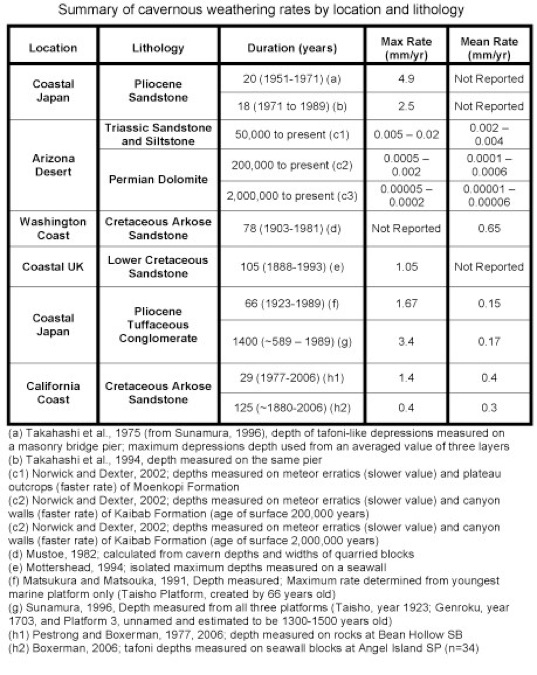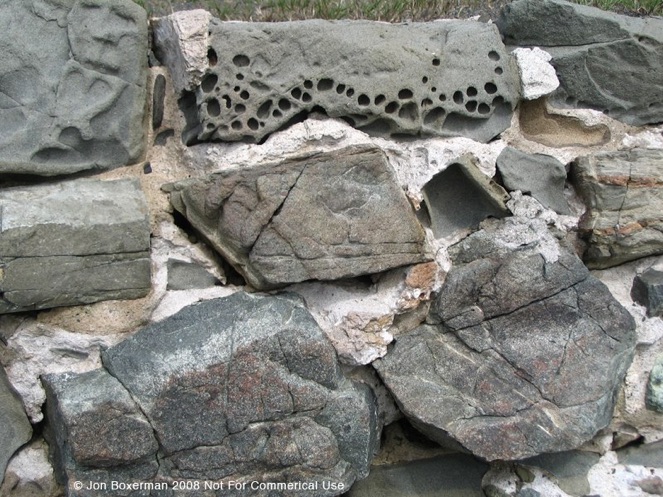Evolution
How Fast Do Tafoni Change over Time?
Palaeo-climates. Some scientists study tafoni to help unravel palaeo-climatic conditions of the Holocene and the Pleistocene. Others explore the complex relationship between the presence of tafoni and palaeo-climatic conditions (Andre and Hall, 2004; Calkin and Cailleux, 1962; Kejonen, Kielosto, & Lahti, 1988; Kelletat, 1980; Martini, 1978;). Butler and Mount, (1986) examined fist-sized honeycombed cobbles to delineate ancient Pleistocene lake shorelines in the Nevada Desert. Sancho, Fort, and Belmonte (2003) found an exponential increase in weathering rates of historic seawalls in Spain likely related to environmental changes during the last millennium. Researchers find that tafoni deepen with time by measuring the depth of tafoni on the faces of exposed uplifted marine platforms with dates of uplift recorded in the historical record (Matsukura and Matsouka, 1991; Matsurkura, Matsuoka, & Yano, 1989; Sunamura, 1996; Suzuki & Hachinohe, 1995;).

Controls on Rates of Change. The controls on rates of tafoni initiation and development depend on climatic and lithologic variations. It seems likely that variations in the rates of tafoni development depend on climatic factors like the periodicity of wettings, length of desiccation period, and the temperature and humidity profile inside the cavity and lithologic factors such as porosity and permeability. Researchers working in coastal areas of Japan find that tafoni pitting begins only after some amount of time transpires, known as a lag time. Once a pit is established, tafoni preferentially increase in depth, and assume a non-linear (i.e., non-constant) and asymptotic rate of growth. Over time, the rate of tafoni deepening decreases exponentially (Sunamura, 1996).
-
•Climatic differences. In dry climates, (limited) measurements of tafoni enlargement rates indicate tafoni development is approximately 2-4 order of magnitude slower than for tafoni forming in more moist environments in comparable rock types. In arid deserts, rates of deepening may proceed slowly, sigmoidally, and protract over many thousands to millions of years (Norwick & Dexter, 2002), perhaps because of the large heat fluctuations and relatively long periods between wetting episodes. A slow gradual development may account for the apparent greater range in cavern volumes typical of tafoni in drier climates. On the other hand, near-shore, coastal sandstone tafoni, which are frequently wetted by with saline-rich sea spray, wave splash, and ocean mist, enlarge at a rate on the order of millimeters per year (hundred to thousand year time scales)
Huinink, Pel, and Kopinga (2004) found that the (simulated) growth of tafoni is fastest when the drying period is long and evaporation rates are slow. Frequency of wettings with saline solution and length of drying between wettings seems to play a significant role in affecting rates of change. Cavity interiors are cooler because they are sheltered from the sun. When moist air enters a cool cavity, it condenses onto the shadier part of the cavity interior, the inner roof and back wall, which may be why differential weathering processes preferentially weather in an upward and backward direction.
-
•Lithologic differences may also account for variability in rates of tafoni change. Pye and Mottershead (1995) found that coastal tafoni is extensively distributed and rapidly developed along a sandstone seawall in the United Kingdom. The tafoni they studied is not present in the limestone blocks capping the sandstone wall, which had been “exposed to virtually the same weathering environment”. Pye and Mottershead found that the homogenous composition of the limestone, the relatively chemically inert combination of calcite and saline moisture, and the limestone’s low porosity and permeability, seemed to inhibit tafoni formation. Norwick and Dexter (2002) found that tafoni rates of change in Triassic fine-grained sandstones and fissile siltstones are “much faster” than tafoni growth rates in Permian sandy dolomites.
